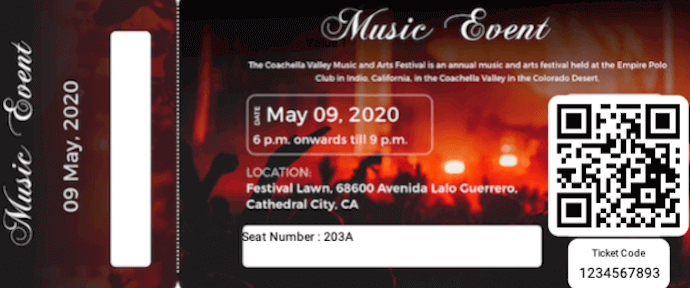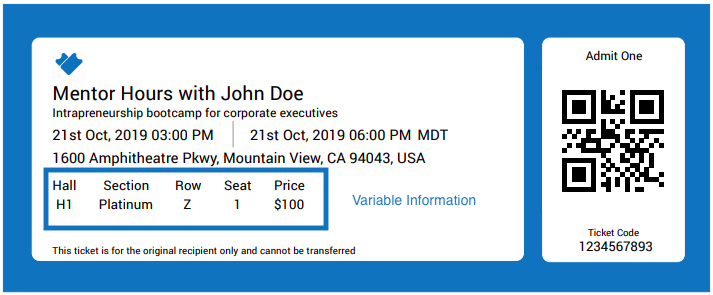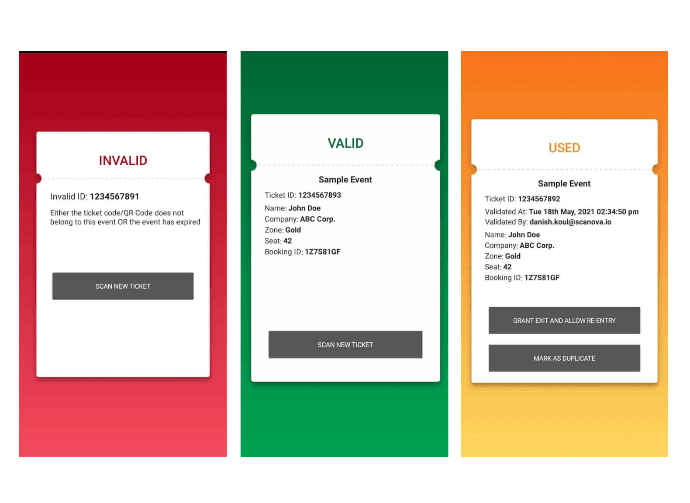Are you struggling to sell tickets for your event? Perhaps it's time to revisit your ticketing strategy.
You may think ticketing is just about selling tickets, but it's so much more than that. You need to think of your event ticketing strategy as a way to engage potential attendees and drive them toward purchasing their tickets.
It starts with understanding your audience and their preferences.
In this guide, we'll take you through the different ticketing strategies and how to design an effective one that will help you sell more tickets and maximize revenue.
Let's get started.
A. Event Ticketing Strategies: The core pillars
Before you dive into the different types of ticketing strategies and how to sell more tickets, it's essential to understand the three core pillars of event ticketing:
1. Ticket type
The ticket type is also an essential factor for event ticketing strategy. It's always better to offer different types of tickets and price points so that more people can attend your event.
For example, if you're hosting a concert, you might offer VIP passes and general admission tickets.
2. Pricing model
The pricing model is another critical pillar of a ticket strategy. The pricing model should be designed to attract attendees while ensuring a good return on investment for the event.
You should employ a pricing model considering early bird discounts, late fees, bundled pricing, group discounts, etc. Dynamic pricing is another pricing model that adjusts ticket prices based on real-time data. We will dive into them later.
3. Ticket design
Ticket design is one of the core pillars of ticket strategy. The ticket design should be visually appealing, include essential information, and have a clear call-to-action (CTA).
You can incorporate branding elements into the ticket design and make it unique.
4. Ticket distribution
The next pillar of a ticket strategy is ticket distribution. The ticket distribution process should be user-friendly and convenient, whether digital or physical.
You need to decide how and where they will sell tickets and ensure accessibility for all users. It should be automated and easy to use. The ticketing system must have a simple user interface that allows customers to purchase tickets in just a few clicks.
Now let's look at each pillar to create an effective ticketing strategy.
B. Event ticketing strategies: Decide the ticket type
If you want to sell more tickets, you need to understand that different ticket types have different price points and benefits for the customer.
For example, if you're running an event that appeals to families with children, consider offering discounted child tickets or free admission for kids under 12. If your event is high-end luxury, premium VIP tickets may be appropriate.
Here are the different types of tickets you can offer:
1. General admission
The general admission ticket type is the most common and straightforward option. It allows attendees to enter the event without any special privileges or reserved seating.
General admission tickets are often priced at a standard rate and are suitable for events where attendees have equal access to all areas.
2. VIP tickets
VIP tickets are a premium ticket type that offers enhanced benefits and exclusivity to attendees. These tickets typically come at a higher price than general admission tickets and provide perks such as priority entry, access to VIP lounges or areas, meet-and-greet opportunities with performers or speakers, and complimentary refreshments.
VIP tickets appeal to attendees willing to pay for a more exclusive and enhanced event experience.
3. Reserved seating
Reserved seating tickets are ideal for events held in venues with designated seating arrangements. With reserved seating tickets, attendees can access specific seats or sections, ensuring they have a guaranteed spot in a desired location.
This ticket type is popular for concerts, theatre shows, and sporting events where attendees prefer a specific view or seating area.
4. Group tickets
Group tickets are designed for attendees, such as friends, families, or coworkers, who plan to attend the event as a group.
Event organizers can offer discounted prices for group bookings, encouraging attendees to bring more people and increasing ticket sales. Group tickets foster a sense of community and make attending the event a shared experience.
5. Season passes
Season passes are advantageous for events that span multiple days, weeks, or months. These passes provide access to all days or sessions of the event at a discounted price compared to purchasing individual tickets for each day.
Season passes attract attendees interested in attending multiple events within a series and offer them the convenience of a single purchase.
C. Event ticketing strategies: Pricing model
Now that you have the design types, the next step is choosing the pricing model for your event, which is another critical decision affecting your bottom line.
Here are the most common pricing models:
1. Early bird Pricing
Time-based pricing is an excellent pricing model for events where the ticket demand can change based on the time of purchase. It is recommended when you want to incentivize early ticket purchases and create a sense of urgency around your event.
If you're organizing an event such as an annual festival, conference, or limited-time exhibition, you can use early bird pricing within the first few weeks of ticket sales. You can then gradually increase the ticket prices as the event date approaches to reflect increased demand and urgency.
Early bird pricing is a common example of time-based pricing, where tickets are offered at a discounted rate for a limited period to incentivize early purchases. As the event date approaches, ticket prices gradually increase to reflect the growing demand and urgency to secure a spot.
You don't have to make your early bird registration offer a set amount of money off the regular fee. You can offer a coupon code or discount on another event to promote this one.
You can offer a promotional item or swag bag item to incentivize customers to register early. Just make sure you limit how many early bird offerings there are so nobody gets angry at missing out.
2. Dynamic pricing
Dynamic pricing is a perfect pricing model for events where ticket demand can change based on factors such as availability and market conditions. This pricing model is recommended when you want to maximize revenue by adjusting ticket prices in real time.

This is also a good option for events that are expected to sell out quickly and where demand may fluctuate throughout the year. This pricing model can be used to offer lower prices during low-demand periods, such as when tickets go on sale or when you’re trying to fill empty seats during slow periods.
3. Tiered pricing
Tiered pricing is ideal for catering to different audience segments with varying preferences and budgets. It's an excellent pricing model when you have different access levels or perks available to attendees.
If you're organizing an event like a business conference or a music festival, you can use tiered pricing to create various ticket tiers.
For instance, you can offer a basic pass with general admission, a VIP pass with access to exclusive areas, or a backstage access pass with meet-and-greet opportunities. This model ensures attendees can select the level of perks they prefer, and you benefit from additional revenue.
4. Package pricing
Package pricing is a perfect pricing model when offering bundled tickets or experiences at a discounted rate. Package pricing works well for various events, including concerts, sporting events, and festivals.
If you're organizing a multi-day event, such as a music festival, or a multi-discipline event, such as a business conference, you can package tickets for different days at a discounted rate.
You can also include additional perks such as merchandise, backstage passes, or exclusive meet-and-greet sessions to create a comprehensive experience. This model ensures attendees have a comprehensive and immersive experience, and you benefit from increased sales.
5. Group pricing
Group pricing is ideal when you want to incentivize attendees to bring additional people to your event. It's recommended when you're organizing an event where attendees are likely to come in groups.
Offering discounts for groups is a great way to get more attendees when organizing an event.
This model ensures that attendees can bring friends, families, or colleagues and enjoy the benefits of group rates. It can also create a sense of community and encourage social interaction between attendees.
D. Tips for structuring pricing that appeals to customers
Here are some tips for structuring your pricing model:
1. Offer multiple pricing levels
Providing multiple pricing levels, or tiered pricing, is an effective way to cater to different customer segments and their varying budgets and preferences.
Offering different access levels or benefits at varying prices can attract a broader range of customers and maximize revenue.
Tailor your pricing tiers to align with your target audience's unique needs and desires.
2. Use limited-time offers and scarcity
Creating a sense of urgency and scarcity can encourage customers to make purchasing decisions quickly.
When you use limited-time offers or scarcity tactics such as "only 5 spots left" or "expires in 24 hours," customers will take action and overcome price resistance.
However, be careful not to overuse these tactics, as they may lead customers to question the authenticity of your pricing and promotions.
3. Highlight social proof and testimonials
Social proof is a powerful psychological factor that influences customer behavior. Incorporate testimonials, reviews, and success stories from satisfied customers into your pricing strategy.
When potential customers see that others have derived value from your product or service, they are more likely to perceive it as worth its price. Leverage the power of social proof to build trust and credibility in your pricing.
4. Offer bundled packages and add-ons
Bundle pricing can be an effective strategy to increase perceived value and customer appeal.
You can increase the value of your product or service by offering discounts or “bundling†deals on additional products, services and/or perks. This will encourage customers to make a higher-value purchase.
Additionally, offering add-ons or upsells during the purchasing process can further enhance the perceived value and provide customers with additional options to customize their experience.
5. Frame your pricing in the right way
How you frame your prices can have a significant impact on customer perception. Utilize strategies such as ending prices with .99 instead of rounding them up, as customers often perceive the .99 price as being significantly lower.
Additionally, presenting higher-priced options first can create a contrast effect that makes subsequent options appear more affordable. Experiment with different price frames to see which ones resonate most effectively with your target audience.
E. Event ticketing strategies: Ticket design
This may seem like a minor detail, but the design of your tickets can significantly impact how many people purchase them.
Here's how you can design your tickets to maximize sales:
1. Clear and eye-catching design
Your tickets should have a clear, visually appealing design that captures the attention of potential attendees. Use high-quality graphics, colors that align with your event branding, and eye-catching fonts.
Incorporate elements of your event theme or include images associated with the event to connect the ticket and the experience attendees can expect.
A well-designed ticket looks professional and creates anticipation and excitement for the event.
2. Important information at a glance
Ensure all essential information is clearly visible and easily found on the ticket. Include details such as the event name, date, time, venue, and special instructions.
Use a font size and style that is easy to read, even at a glance. Make sure ticket holders can quickly identify the critical information they need, which helps avoid confusion and frustration.
3. Ticket QR Codes and security features
Incorporate QR Codes into your tickets to streamline check-in and enhance security. QR Codes can be scanned quickly, allowing event staff to validate tickets efficiently.

Additionally, consider integrating security features such as holographic elements, tamper-proof labels, or unique identifiers to prevent counterfeit tickets. These features provide a sense of legitimacy to your event and also help protect your attendees and your revenue.
4. Balance between attractive and informative
Ticket design is all about balance. A visually compelling ticket that isn’t easily understood can be just as much of an eyesore as one that lacks style but is easy to read.

Consider using a combination of colors, fonts, and graphics to ensure your tickets are easy on the eyes while still providing the information event staff and attendees need.
5. Use ticket templates
One of the easiest ways to design impressive tickets is by using templates. With Ticket Generator's multiple templates, you can choose a design that best suits your event theme and style.
The user-friendly interface allows you to easily customize your tickets, adding your branding elements, event details, and any necessary security features. Their ready-to-use templates save you time and effort while ensuring professional-looking tickets that maximize sales.
F. Event ticketing strategies: Ticket distribution
Selling tickets for your event can be a daunting task! Allocating the right number of tickets, avoiding overselling or underselling, and ensuring a seamless ticket distribution process can make or break the success of your event.
Here are some strategies to ensure smooth ticket distribution:
1. Use a ticketing platform
Invest in a modern ticketing platform that can help you manage ticket sales and oversee ticket distribution.
The ticketing platform will allow you to automate the ticket purchase process, which reduces the chance of human error. It also allows you to manage your inventory and track how many tickets have been sold.
With Ticket Generator, you have multiple sharing options. All you have to do is, design your tickets and send them in the preferred format.
You also have access to a customer database with all the information about your customers and how many tickets they purchased. This can be useful for sending reminders about upcoming events in your area or even offering special discounts on future purchases.
2. Set up multiple ticket distribution points
Provide your customers with multiple avenues to purchase tickets to your event. Ticket distribution can be extended to multiple distribution points, for example, physical locations, online ticket sales platforms, event websites, and social media pages.
Make it easy for your customers to find your event and purchase tickets with their preferred method of payment. This can also be a great way to expand your reach and target a wider audience.
3. Ensure security
There are chances that people use the same ticket twice. To avoid this, you can use a ticket validator or a scanner. This will also help you to make sure that the tickets are not counterfeit.
Ticket Generator comes with a free ticket validator app, so you can use this to check whether the tickets are valid or not.

It can also enhance security and prevent fraud by making it more difficult for anyone to duplicate or modify the tickets.
G. What's your next step?
Now you have everything you need to create your event ticketing strategy; the next step is selling your tickets.
Here's the action plan to follow right after you finish reading this guide:
- Decide the type of ticket you want to create. Don't spend too much time on this step, but make sure you understand what your audience wants
- Select the pricing model that's right for your event. Don't forget that different pricing models can be used to sell different types of tickets (e.g., single-day vs. multi-day passes)
- Create the ticket design and ensure it's consistent with your brand identity
- Start promoting your event registration form and the tickets you sell
If it's too hard to design your ticket, use professional templates from Ticket Generator and start sending your first 10 tickets for free.





.gif)






